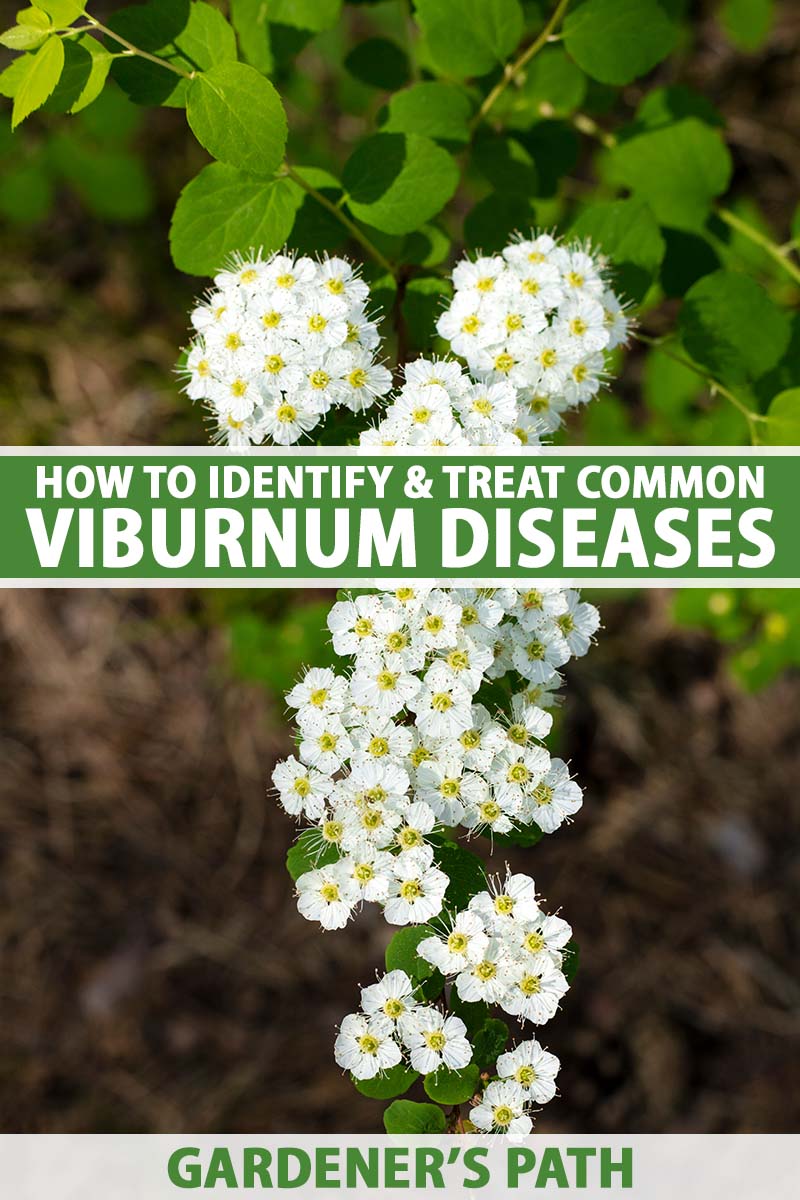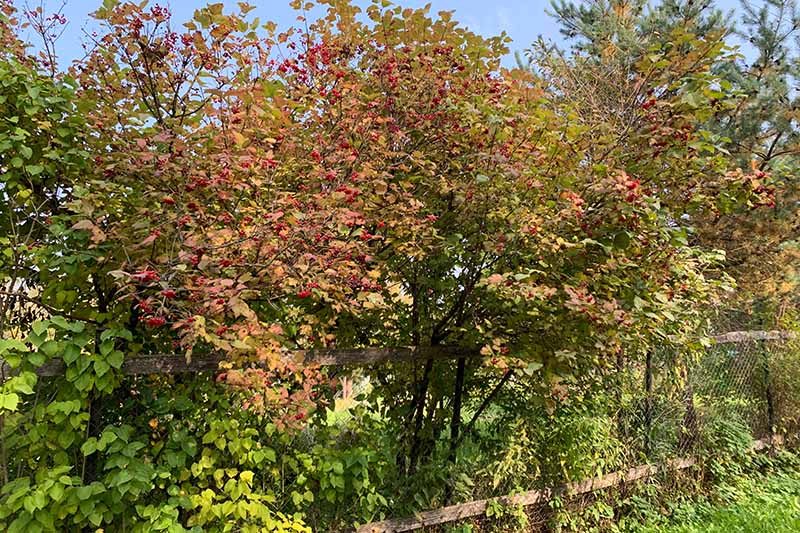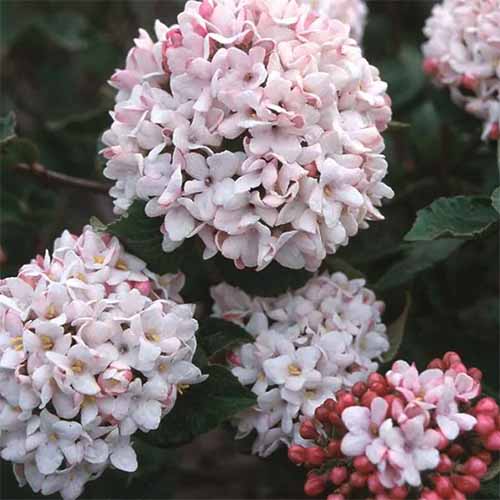Most species are woody shrubs, though some have a spreading growth habit, and others can be pruned into a tree-like form. These versatile, low-maintenance plants are easy to grow and – depending on the species and growing zone – will thrive in shady locations or full sun. We link to vendors to help you find relevant products. If you buy from one of our links, we may earn a commission. In this article, we provide an overview of the major diseases that may affect viburnum, most of which are treatable, and we explain how to control them. Here’s what we’ll cover: Fortunately, viburnum is generally resistant to most diseases. Infected plants typically have been weakened by improper care or are in poor health otherwise. Therefore, you should be able to prevent disease by ensuring that their needs are met. Growing these shrubs in full sun will help to prevent many of these diseases, which typically occur in damp, moist conditions. If the plant has grown very densely, the interior may retain moisture. Pruning the branches in the center of the plant can help to increase airflow and prevent a build up of humidity. Also remove any plant material that falls to the ground, since it may harbor disease-causing organisms. If, in spite of your best efforts, your shrub appears to have come down with symptoms of a disease, it’s likely to be caused by one of the following six conditions:
1. Algal Leaf Spot
As its name indicates, this disease causes an infection that shows symptoms on the leaves. The spots start out small and pale green before becoming reddish or light brown. They often have feathered edges and look like they are slightly raised.
2. Armillaria Root Rot
Unfortunately, species of Armillaria (the honey mushroom) are found in soils throughout the world, and may cause fatal infections on a variety of trees and shrubs, including viburnum. The organism that causes it, a type of algae known as Cephaleuros virescens, overwinters in the leaf spots, ready to strike again in springtime. You can control algal leaf spot with copper fungicide, such as this one from Bonide that’s available from Arbico Organics. Bonide Liquid Copper Fungicide Treat your viburnums when you first see the symptoms, then repeat every 10 to 14 days until the disease is under control. You may have no idea that your shrub is infected until it suddenly dies. Symptoms include yellowing of the leaves and stunted growth. You can observe signs of the presence of this fungus as a white mat if you peel back the bark near the bottom of the shrub. Sometimes there will be stringy black growths on the roots or the soil surrounding your plant that are known as rhizomorphs or shoestrings. There is no cure for this disease, and if you discover that your viburnum has a severe infection, you should immediately dig it up and destroy it in the trash, not on your compost pile. Try and remove as many roots as you can and destroy those, too. This will help to prevent the fungus from remaining in the soil and infecting other plants. In addition, you should remove the soil from around the root zone and dispose of it. You will not be able to grow viburnum in the same area once the soil has become infected. However, healthy plants are less likely to contract this disease, so make sure the soil drains well, fertilize properly, and provide additional water during periods of drought.
3. Botryosphaeria Canker
This fungal infection is serious, but fortunately it only afflicts shrubs that are already in poor health. Your viburnum will be the most susceptible if it’s drought stressed, so be sure to provide additional irrigation during dry spells. Areas of the shrub that have been pruned or that have damaged bark are also vulnerable to invasion by this fungus. Healthy plants will generally ward off such infections, but they can spread in unhealthy ones. The first indication of this disease is leaves that wilt and die. Next, the branches die. They will be covered with black or dark brown pimple-like fruiting fungal structures. If you look under the bark, the wood will be dark brown. The afflicted areas will eventually become sunken, causing cankers to form. The cankers start out small, but they can grow together to form larger ones that can girdle the affected trunk or branch. This prevents water from moving throughout the plant. Areas with cankers may fail to grow leaves the next spring. Prune back the branches that are infected. Cut them all the way back to the green healthy wood, and sterilize your pruning shears between cuts. If you have to prune an entire branch, cut just outside of the branch collar and do not make the cut flush with the trunk. Be sure to destroy the material you pruned, since it contains fungal spores that could spread. If you have mulched your shrub, it will be more resistant to mechanical injury from lawn mowers and weed wackers. Apply two to four inches of leaf mold, bark, or pine needles. Do not pile the mulch up against the trunk.
4. Downy Mildew
This is a disease that doesn’t kill its host, but it can be debilitating on viburnum. Downy mildew is caused by Plasmopara viburni, and it is typically a problem when the weather is wet in the spring and moisture builds up on the leaves. Symptoms include angular spots between the leaf veins that grow larger and cause the leaves to redden and turn brown before they shrivel up and die. The underside of the leaves will be covered in white fungal growth. You can take measures to prevent this disease by raking up and destroying any infected leaves. It is particularly important to do this when the leaves fall to the ground in the autumn. Any diseased leaves that remain on the ground can cause infections when the rain splashes the spores to the new growth. Do your best to keep the leaves dry. For example, avoid using overhead irrigation, and water only at the base of the shrub. Prune any overhanging tree limbs or adjacent shrubs that might be growing into your plant, causing a damp, humid environment. If you observe this disease, apply a copper fungicide as soon as possible. However, be sure to avoid those containing sulfur, since they can be toxic to viburnum.
5. Fungal Leaf Spots
While these diseases can be unsightly, they generally do not cause serious problems on viburnums. A number of types of fungi can produce leaf spots on viburnum, including species of Cercospora, Phoma, and Phyllosticta. These infections occur first on older leaves. Moist conditions in the summer typically favor these diseases. The leaf spots generally start out being angular or irregularly shaped, and the tissue in the lesions is sunken and dry. As they enlarge, the spots can merge into larger lesions and turn grayish brown or reddish in color. In addition, species of Colletotrichum can cause anthracnose, which leads to leaf spotting as well. Anthracnose first shows up as reddish-brown spots on the foliage. If left unchecked, dark, sunken areas develop as the tissue dies. In the case of a severe infection, it may spread to the stems. You can often prevent these infections by keeping the leaves dry, by avoiding overhead irrigation and improving air circulation. Pruning any overhanging trees around the diseased plants will reduce the levels of humidity and help the foliage to dry as well. If the infection is minor, remove the spotted leaves. Rake up any infected leaves and destroy them. These steps will help to minimize the chances that your shrub will be reinfected during the next season. In the case of severe infections, you can treat the plants with copper fungicide when you first see symptoms and repeat at 10- to 14-day intervals as needed.
6. Powdery Mildew
Powdery mildew is caused by Erysiphe sparsa fungi, which will appear as white, powdery growth on the top of the leaves of young plants, and sometimes the undersides as well. It typically causes little damage. However, severe infections can cause the newly developing leaves to become deformed. Humidity favors the development of this disease, and it is typically a problem when the days are warm and the nights are cool. Rain inhibits its development. Viburnums growing in the shade are more likely to become infected. You can prevent powdery mildew by pruning the branches in the interior of the plant, to improve airflow. Also be careful when you are watering, and just water the ground and not the foliage. Consult our guide for more information about treating powdery mildew. If powdery mildew is a common problem in your area, you can plant cultivars that have some resistance, such as V. burkwoodii ‘Mohawk’ or V. carlecephalum ‘Cayuga.’ V. carlecephalum ‘Cayuga’ You can find V. carlecephalum ‘Cayuga’ plants in #3 containers available from Nature Hills Nursery.
Keep Your Viburnums Healthy
Viburnums generally do not contract diseases and are usually fuss-free, healthy plants. However, when the shrubs face adverse growing conditions, such as drought stress or excessive amounts of moisture, fungal pathogens have an opportunity to take hold. Have your viburnums come down with a disease? If so, let us know how it worked out for you in the comments section below. And for more information on growing shrubs in your garden, check out these guides next:
How to Grow and Care for English HollyHow to Grow and Care for Japanese Tree LilacsBlue Star Juniper: How to Grow These Hardy Garden Staples




